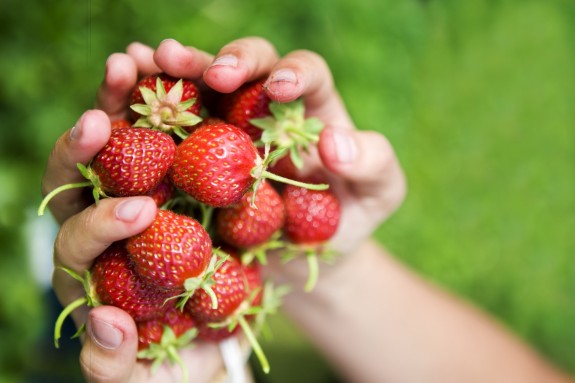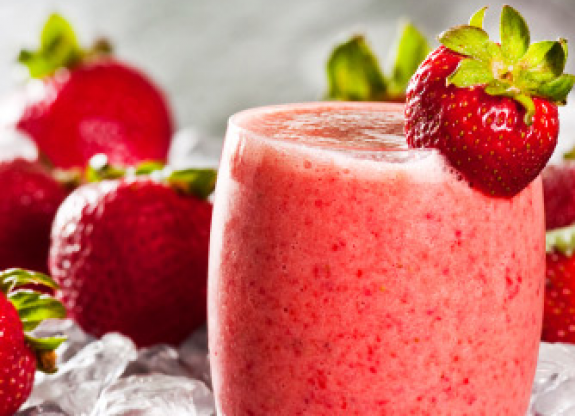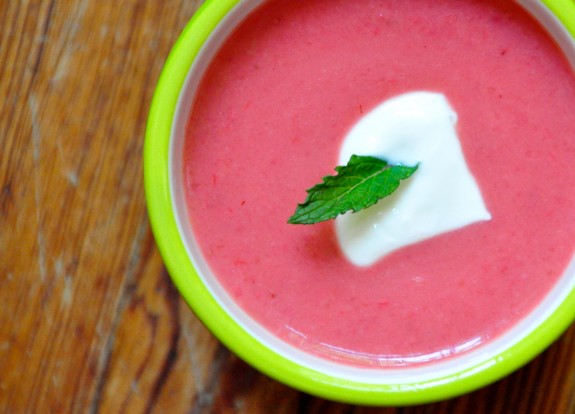Intensely Flavored Strawberry Sherbet in 5 Minutes
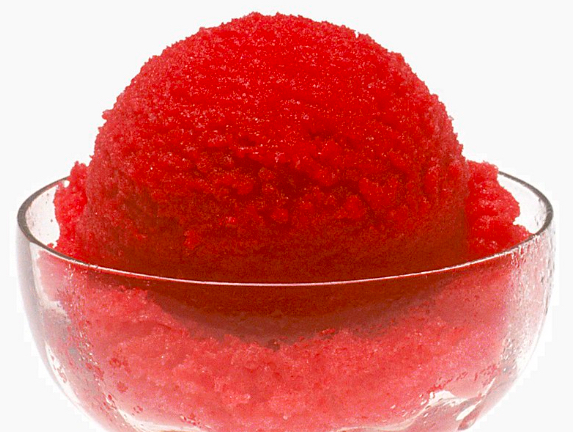
Berry Sherbet (Photo by Renee Comet, Photographer, for the National Cancer Institute – from Wikipedia.org)
5 Minutes? Yes, you heard right. Through the Salvation Army, I teach people recovering from drug and alcohol addiction – and often from the criminal justice system – the importance of including fruits and vegetables in their diets. Sound boring? It certainly could be. But not when we make recipes like this 5 Minute Strawberry Sherbet, adapted from a recipe by Kelly Senyei. It’s a sure-fire way to make anyone actually crave fruits for dessert in place of less healthy choices.
This sherbet (sherbets often contain dairy, while sorbets don’t) is luscious, creamy, and intensely flavorful. I bought the strawberries at the local Farmers Market for maximum succulence. The class hulled the berries and placed them evenly on a baking sheet. Then they (the strawberries, that is) went into the blisteringly cold Salvation Army walk-in freezer. While waiting for the berries to freeze, we reviewed a little lesson about the health benefits of strawberries. The class was especially excited hearing about strawberries’ potential for reducing inflammation, the risk for cancer, heart disease, diabetes, cognitive decline, for stimulating the immune system, and more. They learned about oxidation’s role in increasing disease, and how the more than 100 nutrients in strawberries serve as antioxidants, reducing the risk for those diseases.
I love teaching people who really need help and who benefit so much from my counseling and classes, from people with low literacy and low income, to sophisticated folks – in my classes and private practice. It is amazing how delicious food naturally attracts anyone to a healthy way of eating and living.
Here goes:
Place about 1 cup of Greek yogurt (plain or another flavor, like peach or vanilla) in a food processor. Add 8 cups of frozen strawberries, 2 Tablespoons of freshly squeezed Lemon or Orange Juice, and its zest if you like. Next, add honey or sugar to taste, about 4 to 6 Tablespoons.
Cut the recipe in half for a smaller party.
Blend in the food processor for 5 minutes straight – no peeking! And, voila… you have a rich dessert everyone will love. If you’d like to be extra fancy, serve it in a stemmed crystal glass.
Katherine’s Crepe-Style Swedish Waffles with Succulent Strawberries

Late spring and early summer strawberries are especially sweet and succulent, especially if they are grown locally and picked at peak ripeness. I experienced a very decadent way of enjoying them while relaxing during a recent respite in the Pennsylvania countryside, with my friend, Anna: Smothering heart-shaped Swedish waffles. These aren’t ordinary waffles; they’re crepe-thin, crispy, buttery, and simply divine. Traditionally served on “Waffle Day,” in Sweden, celebrating “Our Lady’s Day,” on March 25th, 9 months before Christmas (also known as the Christian holiday of “Annunciation”). Enjoy…
Katherine & Anna’s Luxurious Swedish Waffles with Strawberries
Serves… You decide the number!
3 eggs
1 dl (3.4 ounces) Flour
6 dl (2.4 cups) Whole Milk (or 1% Milk)
1/4 cup melted, cooled Butter (or Canola Oil or Walnut Oil for a nutty flavor)
Pinch of Salt, Sugar, or Vanilla (optional)
Topping:
1/2 cup (or more) Plain Yogurt, Whipped Cream or Ice Cream
1 cup (or more) Strawberries, other fruit, or preserves like Swedish Lingonberries
1 teaspoon Maple Syrup or Confectioner’s Sugar (optional)
A sprinkling of chopped Roasted Nuts (optional)
1 sprig of fresh Mint (optional)
Whisk the ingredients together in a pitcher. Grease the waffle iron with butter or oil for the first waffle. Since butter (or oil) is in the recipe, the waffle iron will not need to be greased again.
Pour a small amount of the mixture into the Euro Cuisine Eco Friendly Heart Shaped Waffle Maker per product instructions. When golden brown, carefully lift the waffle and place in the center of your plate (smother in butter if you’re being especially care-free and decadent). Place the yogurt, ice cream or whipped cream, berries or other fruit, and roasted chopped nuts, if you wish, on the waffle. Drizzle maple syrup on top. Finish with a sprig of mint.
Lingonberry preserves are widely used in Sweden. They’re sweet and tart, and taste great with plain yogurt or sour cream. They make great toppings for crepes and Swedish waffles.
If you want more of a decadent cake-like dessert, thinly spread butter on the waffle, then sift confectioner’s sugar on top.
NOTE: Using butter, whole milk, ice cream and whipped cream make these delectable waffles occasional dessert treats, and I recommend using them sparingly. When Anna and I prepared them last weekend, we used 2% milk and butter in the recipe. I topped my waffle with Chobani nonfat plain yogurt with a little maple syrup drizzled on top. Anna used whipped cream!
Springtime Strawberry and Goat Cheese Salad
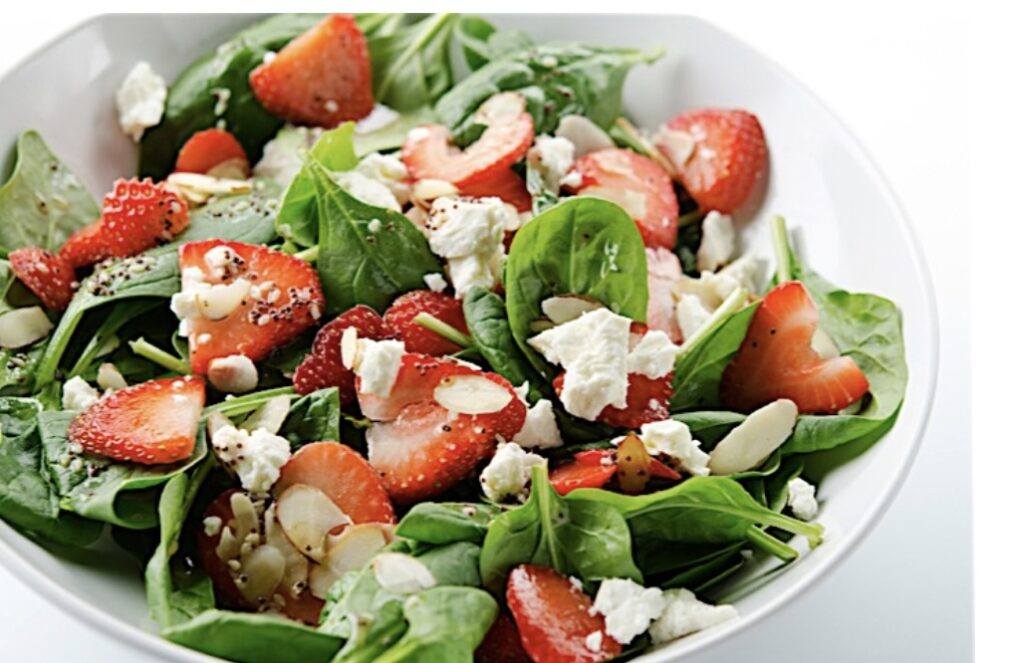
My Favorite Asparagus Recipes
Spring has always seemed more like the new year to me than January first. Perhaps my inspiration comes from longer, warmer, sunlit days, delicate vegetables and fruits, like asparagus and strawberries, finally popping up, flowers blooming everywhere. Neighbors begin venturing out of winter hibernation with their first happy greetings of the year, with sounds of their children playing in the street. Celebrations are occurring all over the city showing off our beauty and splendor to the tourists. In fact, I think I’ll make my New Year’s Resolution today! And it’ll be easy – preparing batches of veggie salads – or soups, at least weekly, to help me and my friends shed some of our winter “padding.” Making delicious veggies your main course at dinners (lunches, too) helps manage your weight easily. Asparagus is one of my major harbingers of spring. Here I’d like to share some of my favorite asparagus recipes excerpted from my book, Diet Simple Farm to Table Recipes: 50 New Reasons to Cook In Season!, where you’ll find dozens of other seasonal recipes:
Chilled Asparagus in a Creamy Tarragon, Shallot and Roasted Walnut Vinaigrette
Salad of New Potatoes and Asparagus with Lemony Garlic Herb Mayonnaise
Pasta with Pesto, Roasted Asparagus and Cherry Tomatoes
Asparagus Salad in a Vietnamese-Style Dressing
Prenatal Fruit Intake Boosts Cognition in Infants + Springtime Strawberry Salad
Some of the most interesting nutrition studies I’ve read have to do with the prenatal diet and subsequent effects in children. The subject is vast and the outcomes amazing. Did you know that when pregnant moms drink high amounts of carrot juice during pregnancy, their toddlers are more likely to choose carrots over other vegetables? Or, that the more varied a pregnant mom’s diet, the more her child will choose and enjoy a wider variety of foods? All proven by science!
So it’s no surprise that a new study published in The Lancet found that prenatal fruit consumption is correlated with superior cognition in the mothers’ one-year-old infants – though there was no effect if fruit was only fed to the child during the year after birth. So, what may explain this finding?
Evolution may explain, in part, this advantage of fruit-eating. During the neolithic (stone age) period about 12,000 years ago and for thousands of years thereafter, we subsisted mainly on fruits and vegetables; which comprised about 65% of our calories, according to S. Boyd Eaton, from the department of Anthropology at Emory University in an interview and in his essay, “Evolution, Diet and Health.” That may mean that brain development is still dependent on the same high level of vitamins, minerals, antioxidants, and other positive nutrients that kind of diet would provide. And this could help explain why, even today, a high fruit diet is correlated with so many positive health benefits: reduced incidence of diabetes, heart disease, cancer, arthritis, eye disease, and other conditions. Keep in mind, too, that the health-giving Mediterranean Diet had 12 to 13 servings of fruits and vegetables daily, and it’s known as one of the healthiest diets on the planet.
Fruit is so easy to eat every day, and the local fruit season is just beginning to get exciting. I was most fortunate to receive one of the most delicious dishes I’ve ever eaten this weekend when my friend and neighbor, Mike Gardner, brought me his salad:
Only Certain Fruits & Vegetables May Cause Weight Loss
- At March 01, 2016
- By Katherine
- In Articles, News
 3
3
For the first time, scientists have discovered certain fruits and vegetables – and not others – are associated with preventing weight gain over the course of many years regardless of calories, according to a recent Harvard study published in the British Medical Journal. These fruits and vegetables contain a class of phytonutrients called flavonoids, a plant compound with anti-inflammatory and anti-oxidant properties, among other benefits.
“The particular fruits and vegetables associated with less weight gain are rich sources of several flavonoid subclasses, particularly flavonols, anthocyanins, and flavones. Animal models and short term human studies provide evidence for underlying mechanisms that relate flavonoids to weight: several flavonoid subclasses have been shown to decrease calorie intake, increase blood sugar uptake in muscle in humans, and decrease blood sugar uptake in fat tissue in test tube studies. Other studies, predominantly focusing on green tea, a rich source of the flavan-3-ol subclass of flavonoids, provide evidence to suggest that flavonoids may decrease fat absorption, increase energy expenditure, and inhibit body fat synthesis,” according to the study.
In the study, anthocyaninins, the blue pigment in many fruits and vegetables, were mainly found in blueberries and strawberries, among others. Flavan-3-ols were mainly from tea, apples, pears, and peppers.
So, while it’s important for your health and weight management to eat at least 5 cups of fruits and vegetables daily, you may want to consider adding these very specific fruits and vegetables to your routine. “An Apple A Day…”
Bountiful Berries
There are very few foods that match the beautiful color and intense flavor of berries. And, fortunately, these fruits are nutrition superstars.
For many years, most berries were regarded as nutritionally inferior because of their lack of traditional essential nutrients such as vitamins A and C. But that was before scientists recently discovered the presence of large amounts of beneficial phytochemicals (“phyto” is Greek for plant).
Apparently, each berry contains at least 100 nutrients and phytochemicals, the plant compounds with potent powers of healing. Some of the most important phytochemicals in berries are antioxidants, powerful substances believed to reduce inflammation, improve immune function and help prevent heart disease and cancers.
Antioxidants are compounds that absorb oxygen free radicals — molecules that cause oxidation in the body’s cells. Scientists believe that these molecules cause most of the diseases of aging, such as immune system decline, arthritis, heart disease, cancer and neurological impairments affecting cognition and balance. Think of oxidation as being similar to rusting. Or imagine an apple slice turning brown. By simply adding lemon juice, an antioxidant, the apple’s flesh stays fresh and prevents the browning or oxidation.
A similar thing happens in your body. Oxidation is constantly occurring in your cells because of environmental pollutants, smoking, exposure to the sun, heat generated through basic metabolic functioning, unhealthy diets and other factors. It takes a large supply of antioxidants to counter this. Berries have been found to have one of the highest antioxidant scores of all fruits and vegetables.
But there are other good reasons to eat berries. The berry family contains 300 to 400 beneficial, disease-fighting chemicals. The phytochemicals in berries, depending on the type, also stimulate the immune system, reduce inflammation, enhance cancer-fighting enzymes, positively influence hormone metabolism, have antibacterial and antiviral effects and may even reverse some aspects of brain aging.
The most potent berries are the more deeply colored varieties, especially blackberries, blueberries and cranberries, followed by raspberries, strawberries and cherries (not technically a berry, but similar nutritionally) but all more potent than most other fruits. Their color (blue/purple) is provided by one of the most powerful phytochemicals, called anthocyanins, which berries synthesize to protect themselves from the elements.
Anthocyanins, a type of polyphenol (polyphenols are also found in other fruits and vegetables), reduce inflammation, according to a 2015 article in the American Journal of Clinical Nutrition, which plays a role in protecting against cancers, heart disease, and other chronic diseases. They may also play a role in preventing risk of Alzheimers and Parkinson’s Diseases, according to many years of animal research published in a 2014 article in Neural Regeneration Research.
Cranberries, may be responsible for helping to prevent urinary tract infections, stomach ulcers, gum disease and even ear infections in children. Cranberries are also effective against antibiotic-resistant bacteria — and 20 percent of urinary tract infections are resistant to antibiotics. The phytochemicals in cranberries work by blocking the disease-causing bacteria and preventing it from adhering to human cell walls.
“There is strong experimental evidence that cranberry bioactives have favorable effects on blood pressure, glucose metabolism, lipoprotein profiles, oxidative stress, inflammation, and endothelial (the lining of blood vessels),” said Jeffrey Bloomberg, et al, in the journal, Advances in Nutrition. But all berries have strong health benefits.
A study published in 2014 in the Journal of Nutrition found a reduction in insulin resistance, especially with Anthocyanins (found in abundance in berries). According to the study, these benefits can be “found with intakes readily achieved in the diet.” They may even improve bone density in women, according to a study published in 2012 in the Journal of Bone Mineral Research and a 2014 article in Osteoporosis International. This may be caused by their antioxidant and anti-inflammatory properties, which may help prevent bone breakdown.
A study published in Neurology in 2012 found a high flavonoids diet (found in berries among other fruits and vegetables) was correlated with a reduction in the incidence of Parkinson’s Disease in men.
Resveratrol
New research has found that raspberries, blueberries, cranberries and huckleberries contain a phytochemical called resveratrol, also present in wine, which is thought to help prevent cancer, cardiovascular disease, and is implicated as an important compound for health.
Strawberries contain large amounts of phytochemicals called ellagitannins, which are also in raspberries and blackberries. Studies at the UCLA Center for Human Nutrition found those berries are capable of inhibiting a number of key steps in the development of cardiovascular disease and may have immense potential for the prevention and treatment of heart disease and stroke. Strawberries are also high in antioxidant Vitamin C and folic acid, important in preventing birth defects.
“Strawberries contain a variety of bioactive compounds that can promote longevity and quality of life. For humans, these compounds can act as antioxidants, serve as anti-inflammatory agents, improve cell to cell communication, cause cancer cells to die, detoxify carcinogens — a number of benefits consistent with health and disease risk reduction.” said Dr. Burton-Freeman at an American Academy of Nutrition and Dietetics conference.
While most of what scientists know about berries has been determined in animal studies and in labs using cell cultures, new human studies are showing promising results.
Berries are an ideal food. Besides being absolutely delicious and colorful on a plate, they’re loaded with nutrients, vitamins, minerals, fiber, and they’re low in calories. They have maximum flavor and nutrient content when picked at ripeness. Freezing them when ripe or buying ripe frozen berries is a great alternative. But, simply ripening a berry on your kitchen counter will increase its phytochemical content, too.
Berries can be eaten morning, noon or night – whatever your preference. I eat berries every morning on my oatmeal. In the summer, I’ll use any fresh local berry but in the winter, I stick with frozen blueberries.
“Berries are extremely versatile; they fit perfectly with any meal or snack,” says Janie Hibler, author of “The Berry Bible” (William Morrow, 2004). In “The Berry Bible,” Hibler provides a berry encyclopedia and berry recipes ranging from smoothies, drinks, and breads to soups, salads, salsas, main courses, and desserts.
So, what are some ways we can eat berries every day?
“A no-brainer,” she says, “is a berry smoothie for breakfast.” For lunch, she says, throw a handful into your salad. For snacks, carry dried berries and nuts. At dinner, berries go beautifully with meats, grains and main courses.
You will eat more berries if you simply keep them on hand and ready to grab. Get them now when they’re fresh and freeze them yourself. Frozen blueberries are fun snacks for kids to pop in their mouths, like hard candy. You can also make berry popcicles, syrups for pancakes and spritzers.
Berry Coulis
Hibler recommends always having berry purees, or “coulis” on hand. “A sauce rivaled by none,” she says. But they also are great added to drinks, smoothies, yogurts, cereal, you name it.
To make a coulis, rinse and drain the berries, process in a food processor. Add a little sugar or even liqueur, if desired. It will keep in your refrigerator for three to four days or be frozen for a month.
Some of my favorite berry recipes:
Spinach and Strawberry Salad with Toasted Almonds and Balsamic Vinaigrette
Katherine’s Spicy Mexican Salsa with Strawberries
Soupe aux Fraises et Rhubarbe (Strawberry Rhubarb Soup)
Kjerstin’s Curried Chicken Salad with Strawberries and Toasted Almonds
Memorable Memorial Day Weekend Recipes
- At May 25, 2012
- By Katherine
- In News, Recipes
 0
0
Have a lovely Memorial Day! My suggestions for wonderful dishes for the holiday, using local, seasonal picked-at-peak-ripeness ingredients… What’s at market now and most delicious? Asparagus, strawberries, onions, potatoes, cherry tomatoes… Enjoy!
Starter: Puree of Asparagus Soup with Tarragon
Main Course: Salad of New Potatoes and Asparagus with a Lemony Garlic-Herb Mayonnaise Topped with Poached Salmon
OR
Main Course: Kjerstin’s Curried Chicken Salad with Strawberries, Grapes and Roasted Almonds
Dessert: Strawberry Granita
# 1 THE SUNDAE SOLUTION
- At December 19, 2010
- By Katherine
- In Articles, News
 0
0
NOW it’s official: You can eat a chocolate sundae every day and still lose weight…
One of my clients, Jennie, almost always snacks in the afternoon. She view these snacks as ‘rewards” for getting through another day of drudgery. Of course, these same snacks contribute to her weight problem.
My advice to her (and I’m pretty proud of it ): Have a chocolate sundae every day.
I know this sounds strange, but here’s why it helps. The chocolate syrup that you pour over ice cream isn’t exactly lean, but that’s okay because underneath the chocolate – the sundae part – is fresh fruit instead of ice cream. Fruit is a lot better for you than ice cream, and the chocolate provides a slightly sinful incentive to make the switch seem worthwhile.
Almost any fruit works with chocolate syrup – strawberries, bananas, peaches, take your pick. Apart from the fact that a fruit sundae is deliciously fresh tasting, filling, satisfying, and low in saturated fat and calories, it makes a great substitute for other snacks that really load on the calories.
THE SUNDAE SOLUTION has been responsible for hundreds of people eating – and LOVING – more fruit. If you try it, you will too!
BOTTOM LINE: Lose 9 to 35 pounds
A tablespoon of regular chocolate syrup has about 50 calories. Pour it over fruit, and your total is about 110 to 160 calories. Compare that to the usual snacks – a candy bar or protein bar, for example, has about 250 calories, and an ice cream cone has about 500 – and you can see why substituting the fruit sundae can lead to impressive amounts of weight loss. Make the switch every day, and you can count on losing 9 to 35 pounds in a year.



